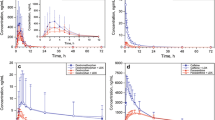Summary.
Seven randomised comparative studies were conducted in healthy volunteers to compare the pharmacokinetic and pharmacodynamic profiles of selegiline hydrochloride in a new formulation designed for buccal absorption “Zydis Selegiline” (1.25–10 mg) with conventional selegiline hydrochloride tablets “conventional selegiline tablets” (10 mg). A total of 156 healthy volunteers participated in these studies. Plasma concentrations of selegiline and its primary metabolites, N-desmethylselegiline (DMS), l-amphetamine (AMT), and l-methamphetamine (MET) were measured using Gas Chromatography Mass Spectrometry (GCMS) and gas liquid chromatography (GLC) assays. Inhibition of monoamine-oxidase type B (MAO-B) and monoamine oxidase type A (MAO-A) activity was determined by measurement of as β-phenylethylamine (PEA) by GCMS and 5-hydroxyindoleacetic acid (5-HIAA) by High Performance Liquid Chromatography (HPLC) assays. Almost a third (2.96 mg) of a 10 mg selegiline dose in Zydis Selegiline was absorbed pre-gastrically (predominantly buccally) within 1 minute. Mean [SD] area-under-the curve (AUC0–∞) values following Zydis Selegiline 10 mg (5.85 [7.31] ng·h/mL) were approximately five times higher than those following conventional selegiline tablets 10 mg (1.16 [1.05] ng·h/mL). In contrast, plasma concentrations of metabolites were significantly (p<0.001) lower following Zydis Selegiline 10 mg than following conventional selegiline tablets 10 mg.
Plasma concentrations of selegiline and its metabolites increased in a dose-dependent manner over the dose-range Zydis Selegiline 1.25–5 mg. Bioavailability was determined using AUC and peak plasma concentrations (Cmax). The Cmax of selegiline was similar following administration of Zydis Selegiline 1.25 mg (1.52 ng/mL) or conventional selegiline tablets 10 mg (1.14 mg/mL). The range of values for AUC0–∞ and Cmax following Zydis Selegiline 1.25 mg were entirely contained within the range following conventional selegiline tablets 10 mg, with a much higher variability of plasma selegiline concentrations occurring after conventional selegiline tablets than after Zydis Selegiline. As expected, peak plasma concentrations for DMS, AMT and MET were consistently lower after Zydis Selegiline 1.25 mg (1.19, 0.34, 0.93 ng/ml, respectively) than after conventional selegiline tablets 10 mg (18.37, 3.60, 12.92 ng/ml, respectively). A significant (r=0.0001) correlation between daily PEA excretion (a measure of brain MAO-B inhibition) and the log-transformed AUC(0–t) for selegiline was demonstrated. Mean daily PEA excretion was similar following Zydis Selegiline 1.25 mg and conventional selegiline tablets 10 mg (13.0 µg versus 17.6 µg). In contrast, there was no correlation between PEA excretion and selegiline metabolites, indicating that selegiline metabolites do not significantly inhibit MAO-B. Urinary excretion of 5-HIAA (used as a marker for MAO-A inhibition) was unrelated to plasma concentrations of selegiline or DMS following single or repeat dosing of Zydis Selegiline 1.25 mg or conventional selegiline tablets 10 mg. However, comparison of treatment groups revealed a significantly lower excretion of 5-HIAA in the conventional selegiline tablets 10 mg group than in the Zydis Selegiline 1.25 mg group after repeated administration over 13 days.
In summary, by reducing the opportunity for first-pass metabolism, the absorption of selegiline from Zydis Selegiline was more efficient and less variable than from conventional selegiline tablets. Compared with conventional selegiline tablets 10 mg, Zydis Selegiline 1.25 mg yielded similar plasma concentrations of selegiline and degree of MAO-B inhibition, but markedly reduced concentrations of the principal metabolites. Thus, the lower but equally MAO-B inhibitory dose of selegiline in Zydis Selegiline 1.25 mg, which is associated with lower concentrations of potentially harmful metabolites, could offer a safer and more predictable treatment in the management of patients with Parkinson’s disease.
Similar content being viewed by others
Author information
Authors and Affiliations
Additional information
Present address: Cephalon UK Ltd., Surrey Research Park, Guildford, United Kingdom
Present address: Biogen Ltd., Maidenhead, Berks, United Kingdom
Present address: Safetymednet, Ruscombe, United Kingdom
Present address: Oxford Glycosciences (UK) Ltd., Abingdon, United Kingdom
Present address: Pfizer UK Ltd., High Wycombe, United Kingdom
Received December 3, 2002; accepted June 30, 2003
Rights and permissions
About this article
Cite this article
Clarke, A., Brewer, F., Johnson, E. et al. A new formulation of selegiline: improved bioavailability and selectivity for MAO-B inhibition. J Neural Transm 110, 1241–1255 (2003). https://doi.org/10.1007/s00702-003-0036-4
Issue Date:
DOI: https://doi.org/10.1007/s00702-003-0036-4




